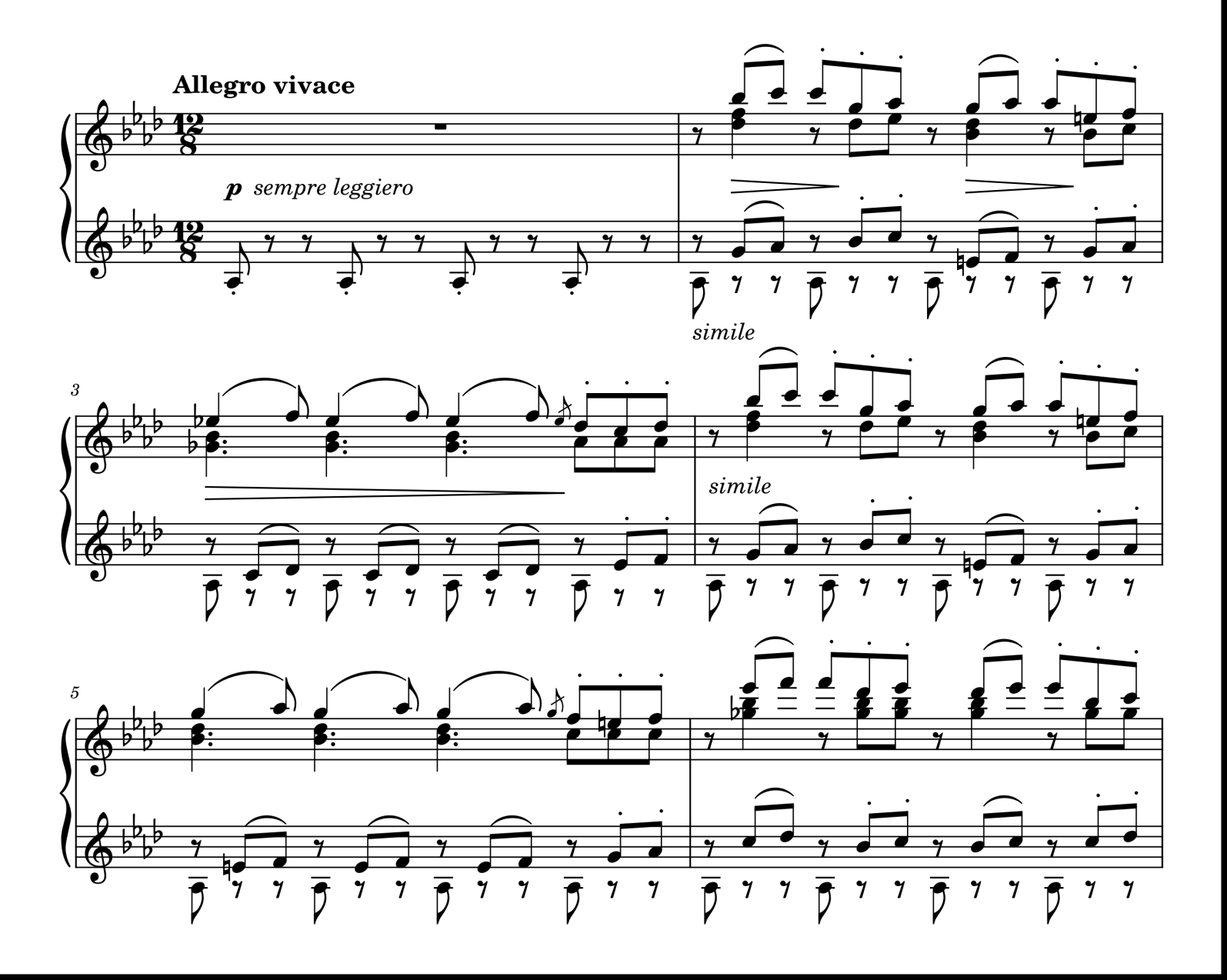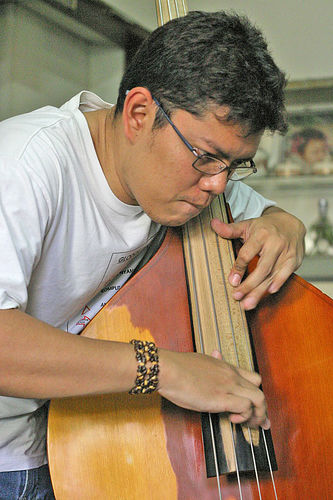|
Fiddle Faddle (musical Composition)
Fiddle-Faddle is a musical composition in 2/2 time composed by Leroy Anderson. It is considered to be a "light" classical music composition, sometimes referred to as "classical pops" music. Fiddle-Faddle was published on January 1, 1947. Arthur Fiedler gave the composition its premiere on March 30, 1947 during a concert radio broadcast from the old Boston Opera House. Leroy Anderson conducted Fiddle-Faddle in a monaural recording for Decca Records on June 29, 1951. Anderson made a stereo recording of Fiddle-Faddle for Decca Records on June 11, 1959. Anderson wrote the piece as one of a number of pieces conducted over time by Arthur Fiedler and the Boston Pops Orchestra. The finished piece instantly became a favorite of audiences and Arthur Fiedler alike. Fiedler programmed it so frequently in Pops concerts that the Pops audiences began referring to it as "Fiedler-Faddle". Written in classic "song-and-trio Within classical European music, the Song and Trio form is often referr ... [...More Info...] [...Related Items...] OR: [Wikipedia] [Google] [Baidu] |
Musical Composition
Musical composition can refer to an Originality, original piece or work of music, either Human voice, vocal or Musical instrument, instrumental, the musical form, structure of a musical piece or to the process of creating or writing a new piece of music. People who create new compositions are called composers. Composers of primarily songs are usually called songwriters; with songs, the person who writes lyrics for a song is the lyricist. In many cultures, including Western classical music, the act of composing typically includes the creation of music notation, such as a sheet music, sheet music "score," which is then performed by the composer or by other musicians. In popular music and Folk music, traditional music, songwriting may involve the creation of a basic outline of the song, called the lead sheet, which sets out the melody, lyrics and chord progression. In classical music, orchestration (choosing the instruments of a large music ensemble such as an orchestra which will ... [...More Info...] [...Related Items...] OR: [Wikipedia] [Google] [Baidu] |
Leroy Anderson
Leroy Anderson ( ) (June 29, 1908 – May 18, 1975) was an American composer of short, light concert pieces, many of which were introduced by the Boston Pops Orchestra under the direction of Arthur Fiedler. John Williams described him as "one of the great American masters of light orchestral music." Early life Born in Cambridge, Massachusetts to Swedish parents, Anderson was given his first piano lessons by his mother, who was a church organist. He continued studying piano at the New England Conservatory of Music. In 1925, Anderson entered Harvard College, where he studied musical harmony with Walter Spalding, counterpoint with Edward Ballantine, canon and fugue with William C. Heilman, orchestration with Edward B. Hill and Walter Piston, composition, also with Piston, and double bass with Gaston Dufresne. He also studied organ with Henry Gideon. He graduated with a Bachelor of Arts, magna cum laude in 1929 and was elected to Phi Beta Kappa."Syncopated Clock, Indeed" ... [...More Info...] [...Related Items...] OR: [Wikipedia] [Google] [Baidu] |
Classical Music
Classical music generally refers to the art music of the Western world, considered to be distinct from Western folk music or popular music traditions. It is sometimes distinguished as Western classical music, as the term "classical music" also applies to non-Western art music. Classical music is often characterized by formality and complexity in its musical form and harmonic organization, particularly with the use of polyphony. Since at least the ninth century it has been primarily a written tradition, spawning a sophisticated notational system, as well as accompanying literature in analytical, critical, historiographical, musicological and philosophical practices. A foundational component of Western Culture, classical music is frequently seen from the perspective of individual or groups of composers, whose compositions, personalities and beliefs have fundamentally shaped its history. Rooted in the patronage of churches and royal courts in Western Europe, surv ... [...More Info...] [...Related Items...] OR: [Wikipedia] [Google] [Baidu] |
Arthur Fiedler
Arthur Fiedler (December 17, 1894 – July 10, 1979) was an American conductor known for his association with both the Boston Symphony and Boston Pops orchestras. With a combination of musicianship and showmanship, he made the Boston Pops one of the best-known orchestras in the United States. Fiedler was sometimes criticized for over-popularizing music, particularly when adapting popular songs or editing portions of the classical repertoire, but he kept performances informal and sometimes self-mocking to attract a bigger audience. Life and career Fiedler was born in Boston, Massachusetts, the son of Johanna (Bernfeld) and Emanuel Fiedler. His parents were Austrian Jewish immigrants. His father was a violinist who played in the Boston Symphony Orchestra, and his mother was a pianist. He grew up in Boston, and attended Boston Latin School until his father retired in the early 1900s, and they moved to Vienna, Austria, in 1910. The family soon moved again, to Berlin, where from 19 ... [...More Info...] [...Related Items...] OR: [Wikipedia] [Google] [Baidu] |
Boston Pops Orchestra
The Boston Pops Orchestra is an American orchestra based in Boston, Massachusetts, specializing in light classical and popular music. The orchestra's current music director is Keith Lockhart. Founded in 1885 as an offshoot of the Boston Symphony Orchestra (BSO), the Boston Pops primarily consists of musicians from the BSO, although generally not all of the first-chair players. The orchestra performs a spring season of popular music and a holiday program in December. For the Pops, the seating on the floor of Symphony Hall is reconfigured from auditorium seating to banquet and cafe seating. The Pops also plays an annual concert at the Hatch Memorial Shell on the Esplanade every Fourth of July. Their performances of both Tchaikovsky's " 1812 Overture" and Sousa's "The Stars and Stripes Forever" are famous for both Howitzer cannons firing and fireworks exploding (during the 1812 Overture) as well as the unfurling of the American flag that occurs as the song enters "The Stars a ... [...More Info...] [...Related Items...] OR: [Wikipedia] [Google] [Baidu] |
Song-and-trio
Within classical European music, the Song and Trio form is often referred as Compound Ternary form. This is where one of the Ternary form sections can be subdivided into two subsections such as: I-II-I or A-B1-B2-A. Examples * Haydn's Piano Sonata in C Major, Movement III * Beethoven Sonata Op.2 No.1, Movement III * Beethoven Sonata Op.14 No.9, Movement II * Leroy Anderson Fiddle Faddle Fiddle Faddle is candy-coated popcorn produced by ConAgra Foods. Introduced in 1967, the snack is commonly found in US Discount store, discount and drug stores. Fiddle Faddle consists of popped popcorn covered with either caramel or butter tof ... Song forms {{classical-composition-stub ... [...More Info...] [...Related Items...] OR: [Wikipedia] [Google] [Baidu] |
Three Blind Mice
"Three Blind Mice" is an English-language nursery rhyme and musical round.I. Opie and P. Opie, ''The Oxford Dictionary of Nursery Rhymes'' (Oxford: Oxford University Press, 1951, 2nd edn., 1997), p. 306. It has a Roud Folk Song Index number of 3753. Lyrics The modern words are: Origins and meaning A version of this rhyme, together with music (in a minor key), was published in ''Deuteromelia or The Seconde part of Musicks melodie'' (1609). The editor of the book, and possible author of the rhyme, was Thomas Ravenscroft. The original lyrics are: Attempts to read historical significance into the words have led to the speculation that this musical round was written earlier and refers to Queen Mary I of England blinding and executing three Protestant bishops. However, the Oxford Martyrs, Ridley, Latimer and Cranmer, were burned at the stake, not blinded; although if the rhyme was made by crypto-Catholics, the mice's "blindness" could refer to their Protestantism. However, ... [...More Info...] [...Related Items...] OR: [Wikipedia] [Google] [Baidu] |
Pizzicato
Pizzicato (, ; translated as "pinched", and sometimes roughly as "plucked") is a playing technique that involves plucking the strings of a string instrument. The exact technique varies somewhat depending on the type of instrument : * On bowed string instruments it is a method of playing by plucking the strings with the fingers, rather than using the bow. This produces a very different sound from bowing, short and percussive rather than sustained. * On keyboard string instruments, such as the piano, pizzicato may be employed (although rarely seen in traditional repertoire, this technique has been normalized in contemporary music, with ample examples by George Crumb, Toru Takemitsu, Helmut Lachenmann, and others) as one of the variety of techniques involving direct manipulation of the strings known collectively as " string piano". * On the guitar, it is a muted form of plucking, which bears an audible resemblance to pizzicato on a bowed string instrument with its relatively sho ... [...More Info...] [...Related Items...] OR: [Wikipedia] [Google] [Baidu] |
Theater Organ
A theatre organ (also known as a theater organ, or, especially in the United Kingdom, a cinema organ) is a type of pipe organ developed to accompany silent films, from the 1900s to the 1920s. Theatre organs have horseshoe-shaped arrangements of stop tabs (tongue-shaped switches) above and around the instrument's keyboards on their consoles. Theatre organ consoles were typically decorated with brightly colored stop tabs, with built-in console lighting. Organs in the UK had a common feature: large translucent surrounds extending from both sides of the console, with internal colored lighting. Theatre organs began to be installed in other venues, such as civic auditoriums, sports arenas, private residences, and churches. One of the largest theatre organs ever built was the 6 manual 52 rank Barton installed in the Chicago Stadium. There were over 7,000 such organs installed in America and elsewhere from 1915 to 1933, but fewer than 40 instruments remain in their original venues. Th ... [...More Info...] [...Related Items...] OR: [Wikipedia] [Google] [Baidu] |
Compositions By Leroy Anderson
Composition or Compositions may refer to: Arts and literature * Composition (dance), practice and teaching of choreography *Composition (language), in literature and rhetoric, producing a work in spoken tradition and written discourse, to include visuals and digital space *Composition (music), an original piece of music and its creation *Composition (visual arts), the plan, placement or arrangement of the elements of art in a work * ''Composition'' (Peeters), a 1921 painting by Jozef Peeters *Composition studies, the professional field of writing instruction * ''Compositions'' (album), an album by Anita Baker *Digital compositing, the practice of digitally piecing together a video Computer science *Function composition (computer science), an act or mechanism to combine simple functions to build more complicated ones *Object composition, combining simpler data types into more complex data types, or function calls into calling functions History *Composition of 1867, Austro-Hungarian ... [...More Info...] [...Related Items...] OR: [Wikipedia] [Google] [Baidu] |



.png)
